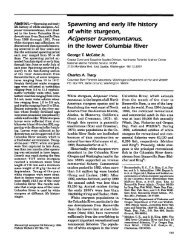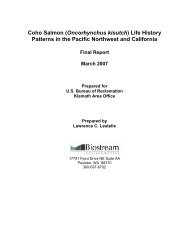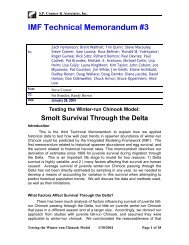STATE OF THE INDUSTRM REPORT - Outdoor Industry Association
STATE OF THE INDUSTRM REPORT - Outdoor Industry Association
STATE OF THE INDUSTRM REPORT - Outdoor Industry Association
Create successful ePaper yourself
Turn your PDF publications into a flip-book with our unique Google optimized e-Paper software.
The future of outdoor retail will hinge on retailers’ ability to meet the consumer<br />
where he or she is. Some people value their gear for its functionality, others<br />
for the potential it inspires. Still others are simply looking for a bargain. All<br />
want retailers to partner with them in fulfilling their active lifestyle aspirations,<br />
whatever they may be. But what will that look like in the individual distribution<br />
channels? Veteran <strong>Industry</strong> retailers have differing opinions. Here’s what some<br />
of them see:<br />
Specialty retail: the mojo<br />
Specialty retailers, repositories of sport-specific experience, traditionally helped<br />
consumers “belong” by facilitating an exchange of knowledge and a good<br />
outdoor vibe along with the cash they charged. For a passionate and plugged<br />
in consumer who cared about brands and products, that was valuable. “In<br />
the old days shops were the community centers,” says Sally McCoy of Silver<br />
Steep Partners, a financial advisory/consulting firm specializing in the outdoor<br />
and active lifestyle industries. But now that outdoor chat rooms and forums<br />
provide information on even the most obscure backcountry areas, the locus<br />
of expertise has shifted. “Consumers have turned their focus to destinations,”<br />
says McCoy. Specialty retailers must establish their relevance by developing<br />
inclusive and trusting relationships with customers. Cabela’s CEO Dennis Highby<br />
thinks expanding beyond the traditional storefront is the best way to do that. “Our<br />
multi-channel approach gives us a tremendous advantage over competitors,” he<br />
says. “All our business segments—retail, direct and financial services—build on<br />
each other.”<br />
“i get most of my input from non-industry companies.<br />
consumers’ expectations are formed at Banana<br />
republic or Whole foods.”— matt hyde of rei<br />
The result is a tailored brand experience that’s convenient and meaningful<br />
for a consumer who is pressed for time and increasingly interested in the<br />
lifestyle aspect of their sport or activity. Other specialty retailers agree. “Our<br />
greatest strength is one-on-one interaction with the customer,” says John<br />
Mead, President of Adventure 16, a specialty retail chain in southern California.<br />
“However, these days customers expect to see an Internet presence. For us not<br />
to be on the Web is an inconvenience to our customers.” Beyond convenience,<br />
the multi-channel approach equals customer service. With so much competition<br />
that’s a crucial priority. Demands on outdoor retailers are increasingly driven<br />
by excellent retailers outside the <strong>Industry</strong>. “I get most of my input from nonindustry<br />
companies,” says Hyde. “Consumers’ expectations are formed at<br />
Banana Republic or Whole Foods.”<br />
For specialty retailers, developing brand value depends on increasing the quality,<br />
not the frequency, of customer interactions. A specialty store’s Internet site can<br />
act as a virtual water cooler, for example, where enthusiasts from around the<br />
world compare notes and share adventure stories. Catalogs can offer sportspecific<br />
tips and the latest outdoor news. It’s all about reestablishing a sense<br />
of inclusiveness and belonging. Specialty retailers are at their best when they<br />
foster community.<br />
// www.outdoorindustry.org<br />
<br />
<br />
<br />
<br />
<br />
<br />
<br />
% of Respondents<br />
online sales projected to take off<br />
Sales of outdoor product through the Internet grew<br />
considerably between August ’04 and July ’05 from<br />
12% to 16.3% of all outdoor product sales.<br />
According to Forrester Research, Inc., total online US<br />
retail sales are projected to grow at a compounded<br />
annual growth rate (CAGR) of 14% over the next five<br />
years (fig. 1.) while the two main outdoor categories,<br />
equipment and apparel, are expected to grow at 16%.<br />
<strong>Industry</strong> veterans agree—70% of respondents to a<br />
recent online survey predicted the ‘Net to grow 10%<br />
or more in the coming year, and 28% saw growth of<br />
20% or more (fig. 2).<br />
<br />
<br />
<br />
<br />
<br />
Apparel<br />
16% CAGR<br />
16% CAGR<br />
Sporting Goods Equipment<br />
Source “US eCommerce: 2005 to 2010,” Forrester Research, Inc.,<br />
by Carrie Johnson with Brian Tesch, September 14, 2005<br />
<br />
<br />
<br />
<br />
<br />
<br />
<br />
<br />
<br />
<br />
<br />
Internet Sales Growth Percentage 2006<br />
<br />
<br />
Source <strong>Outdoor</strong> <strong>Industry</strong> <strong>Association</strong> online survey of 210 industry<br />
professionals from member companies conducted December 2005.











